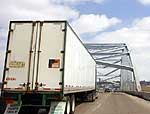By Melanie Sommer
Minnesota Public Radio
April 8, 2002
The southeastern part of the Twin Cities metro area is growing rapidly, and some of the main highways in that region are overtaxed by increasing traffic volumes. The state Department of Transportation begins a massive reconstruction in that area this month.
| |
|
|
|
||
Highway 61 through southern Washington and Dakota counties is two lanes wide in each direction, and several stoplights along the highway cause daily traffic jams. The Interstate 494 bridge over the Mississippi River (also known as the Wakota bridge), is one of the metro area's major traffic bottlenecks, because it carries only two lanes of traffic each way.
Plans to reconstruct the corridor have been in the pipeline for more than a decade. The first shovel of dirt will be dug this spring, and the massive project will take six years to complete. That's more than 15 years from start to finish, on what admittedly is one of the most complex and expensive highway reconstruction projects the state has ever undertaken. The estimated cost tops $250 million.
DOT Commissioner Elwyn Tinklenberg says the average time it takes to develop and complete a highway project in the state is 10 years - half of that time is needed just to conduct an environmental study.
He says another reason for the long completion period is Minnesota's requirement for municipal consent, which means each community affected by a given project has to give its approval, or the project cannot go forward. In this case, at least four local governmental bodies had to approve the plans - in essence, each one had veto authority over the entire project.
Minnesota is the only state which has a requirement for municipal consent on highway projects, and Tinklenberg says the Legislature recently added a similar provision to rail projects.
| |
|
|
|
||
That was a factor in the Highway 61 project, particularly for the city of Newport. The highway essentially splits Newport down the middle. Three streets cross Highway 61, providing easy access from one side of town to the other.
The DOT's redesign gets rid of two of those intersections and makes the other one a full-fledged interchange - allowing traffic to move freely on 61, but cutting off some of that local access for Newport residents. As a result, officials from Newport and the DOT negotiated for months until coming up with a final design that all could approve.
The city of 3,700 people was originally expected to pay more than $7 million toward the reconstruction of local streets and interchanges, which would mean a property tax increase of at least $1,000 per year for each property owner.
Newport said it could not approve the project if it didn't get extra aid from the state to pay its share. The state money did come through, and Newport's city council approved the plan on April 25, 2001. The city's share of the cost is now about $1.1 million. It will also lose more than 10 percent of its property tax base to the newly-designed highway.
Business owners along Highway 61 are bracing for several years of difficulties, as the ongoing construction will severely restrict access along the route.
Sources: Minnesota Department of Transportation, South Washington County Bulletin
More Information

